2nd Task 56 Experts meeting
at Darmstadt Technical University
The 2nd Task 56 meeting was hosted by Prof. Knaack at Darmstadt Technical University, Germany.
23 experts from 10 research institutions and 7 commercial companies participated in the meeting.
Invited experts from BASF, MERCK Group and CIIPAG (China International Investment Promotion Agency)
joined the meeting.
Summaries of selected presentations at the meeting are included in this newsletter.
|

The meeting included a lab tour, where Dipl.-Ing Andreas Maier guided through ETA Factory "
The energy efficient model factory of the future" (a,c). A PhD project by Wang Xiang was visted
at the Campus of TU Darmstadt (e). At the end of the meeting,
Jasper van den Muijsenberg from Merck Window Technologies, organized a visit to their premises near Darmstadt for
a demonstration of their Liquid Crystal Window Technology (d).
|
Selected presentations from the Darmstadt meeting
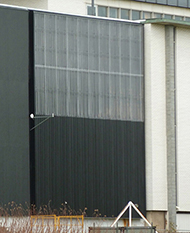 |
Building Integrated Solar Panels Perform Better!
Recent monitoring shows building integrated solar heating systems can provide up to
25% higher efficiency compared with smaller panels tested indoors to ISO 9806 standard. Canada’s National
Solar Test Facility is well known for testing solar panels to various international standards and it has
begun to determine whether larger building integrated solar air collectors perform differently from the
typical stand-alone indoor collector test panels. Over the next few years, a number of air collectors are
planned to be installed on the wall of the NSTF test facility. The first set of results show that a
93 m2 two-stage SolarWall system has a 25% greater efficiency at a low flow rate compared
with the 6.8 m2 panel tested to the 9806 test standard. The testing agency is expected
to quantify the performance enhancements of building integration versus panels mounted on racks for
the range of tests performed under the 9806 standard.
John Hollick, Solarwall, Canada,
jhollick@solarwall.com
|
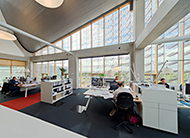
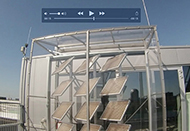
See Lumiduct film
|
Lumiduct – welcome the sun!
The LumiductTM is a one-of-a-kind sun control system that can be integrated into a
building's glazed facade. It creates perfect daylight conditions indoors and combines facade transparency
with high energy performance. Lumiduct consists of a dual-axis tracking, semi-transparent concentrating PV
system that generates electricity with ultra-high-efficiency solar cells, while balancing view to outside,
glare discomfort and low energy demand for heating, cooling and lighting. The thermal energy that is
released in the cavity can be harvested for preheating of ventilation air or other useful purposes
inside the building. Lumiduct is being developed by Wellsun, in collaboration with Eindhoven University
of Technology, Radboud University Nijmegen and other industrial partners. The performance of Lumiduct
is currently being monitored in a full-scale outdoor test-bed. We are working hard to realize the first
fully operational living lab with Lumiduct façade in 2017.
Further reading.
Roel Loonen, Eindhoven University of Technology,
r.c.g.m.loonen@tue.nl
|
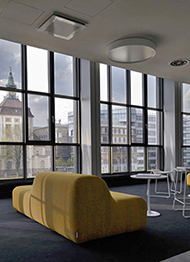 |
Liquid-crystal window by MERCK
Modern architecture is all about transparency and light. Pairing the aesthetic qualities of glass with
functional shading and energy efficiency, however, is a challenge. Now, Merck has revolutionized the way windows
are seen and used. With its new licrivision™, controlling the amount of natural daylight penetration is just a
flip of a switch away. Eliminating of the visual clutter of mechanical blinds, Liquid Crystal Windows enable fast,
sleek, easy-to-use shading solutions. LCW is haze-free and therefore retains the view. Depending on the amount of
visibility and outlook desired, licrivision™ allows for optimal protection of privacy: With its privacy-mode,
the glass can be turned opaque or transparent.
licrivision™ provides new ways of designing with glass, aimed for bespoke large-scale glass skins.
It strives for a clean visual appearance in line with sophisticated premium design aspirations.
With more than 110 years of experience in the liquid crystals business, Merck is the world’s leading
supplier for the display industry. Focused on applications such as flat screen TVs and smart phones,
Merck is now expanding its expertise with a new technology for intelligent window systems – Liquid
Crystal Windows. Merck is the liquid crystal material supplier for this new application and aims to be
the driver for this emerging technology. LC windows go beyond the look, feel and functionality of
regular shading solutions, smart or not, replacing existing systems.
Further reading.
Jasper van den Muijsenberg, Merck,
jasper.van-den-muijsenberg@merckgroup.com
|
| |
SunRise project
SunRise is a R&D project cofounded by the Province of Bolzano.
It aims to design and develop advanced a solar façade system particularly suitable for covering
heating, cooling and hot water demands of typical office buildings. In this the building-integrated
system is embedded in a modular façade element which can be considered in case of new-built or
refurbished buildings.
The solar-thermal energy is harvested through solar collectors, stored in a water storage and
distributed through a radiant heating system. All these components and compact hydraulic box are
integrated in the opaque part of a façade module. The building-integrated solar-thermal system
is thought to be modular by putting a number of façade modules in series to each other.
Auxiliary heating and cooling are possible from the main energy system where solar heat can be
further stored and shared for heating or hot water purposes.
A preliminary assessment of this concept is carried through TRNSYS numerical simulations.
In this context, particular care is dedicated to set properly the boundary conditions for
both building and energy system models since their respective performance
interfere each other. A prototype is built in order to measure the performance of the
solar-active system through laboratory tests.
The development of this prototype is based not only on energetic motivations but also on economic
evaluations. All costs during the lifespan of the building façade are analyzed and optimized in
order to achieve a market price in the range of traditional façade solutions.
Further reading.
Matteo D’Antoni, EURAC Research,
matteo.dantoni@eurac.edu
|
Task 56 session at
12th Conference on Advanced Building Skins
Oct. 2-3, 2016
Bern, Switzerland
Five presentation were given in
Session Block D by Task 56 Experts.
|
Daylight driven and user centered lighting and energy management
W.Pohl, D.Geisler-Moroder
BARTENBACH GmbH, Austria
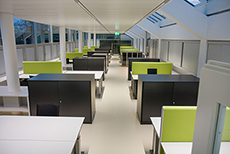
As a part of the EC-funded FP7-project iNSPiRe envelope
retrofitting packages have been developed. The goal was to improve the façade of these buildings by providing
more accessible and affordable energy saving solutions. Bartenbach and research partners at Innsbruck University
have recently developed a dosimetric model for achieving non-visual light effects during the day as well as a
circadian effective artificial light and daylight control scheme.
At the moment the suitability of different daylight systems to realize this light control scheme are evaluated.
Downloads:
[Publication],
[Presentation]
|
Facade integrated HVAC systems for renovation of residential buildings
D.Venus, B.Nocke, C.Fink, K.Höfler
AEE INTEC, Austria
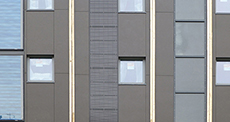
Within the frame of the national research project “Prefabricated façade elements with maximum
integrated HVAC components and systems for the renovation of existing buildings” the potential for the
intelligent renovation of existing buildings should be shown and new solutions should be developed. A
highest possible level of prefabrication should minimize the required renovation time and avoid vacancy.
In particular, the aim is also to find solutions, which allow a direct interaction of the HVAC components
in the building façade with the room behind.
Downloads: [Abstract],
[Presentation]
|
Nordic Built Active Roofs and Facades and Living in Light urban renewal in Valby, Copenhagen
P.Veisig, Cenergia, Denmark
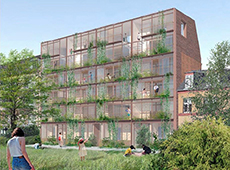
It is estimated, that there will be a large market for
“Active House” building technologies, but also that
this depends stromgly on securing an attractive cost level for the implementation.
During 2017 results will be obtained from ongoing implementation of active building elements in Nordic
Built funded Urban Renewal in Valby and the "Nordic Built Active Roofs and Facades" project dealing with
"Ellebo Garden Room renovation" in Ballerup near Copenhagen.
In some cases it is aimed to reach an energy quality equal to the Danish
low energy class 2015 for urban renewal of old housing blocks.
Downloads:
[Extended abstract]
|
Integration of a sorption collector coupled with a decentralized mechanical ventilation unit in curtain '
wall modules
M.D'Antoni, EURAC, Italy
Over the last few years, a growing attention has been given to the integration of active solar
technologies into the building envelope, so to increase the renewable energy production share and contribute to
reach the goal of net-zero energy buildings. In this context, the layout of an air based solar cooling system
integrated into a façade module was designed and assessed in [1] [2]. This solution utilizes a triple state absorption
module within a Sydney type vacuum tube solar collector to thermally condition an airflow directed to the internal
space reducing the thermal load covered by traditional technologies.
Downloads: [Full abstract]
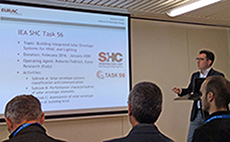
|
Prefabricated timber-frame envelopes for building retrofit with integrated ventilation,
heating system and building services
S.Hernandez, Gumpp & Maier, Germany; F.Ochs, University of Innsbruck, Austria

The objective of the EC-funded project iNSPiRe is to reduce the problem of high-energy
consumption of existing buildings by producing systemic renovation packages that can be
applied to residential and tertiary buildings. The renovation packages aim to reduce the
primary energy consumption of a building to lower than 50 kWh/(m2 a) for ventilation,
heating/cooling, domestic hot water and lighting.
Downloads: [Full paper]
|
Which experts participate in Task 56?
The experts, which contribute to Task 56 are introduced on our public IEA SHC website.
Find a short partner description and the aimed contribution to Task 56
here.
The site is new and will be completed successively. Contact
Subtask leader A. Status: September 2016.
What are the going projects?
Read more about the projects with public funding, which support the work in Task 56. Status: October 2016.
Next Experts meeting in Spring 2017
The next Task 56 experts meeting is planned to take place in connection with the
BIRES 2017 - 1st International Conference on Building Integrated Renewable Energy Systems,
arranged by Dublin Institute of Technology, Ireland March 2-3, 2017. For updates on the experts meeting, please check back
here.
|










